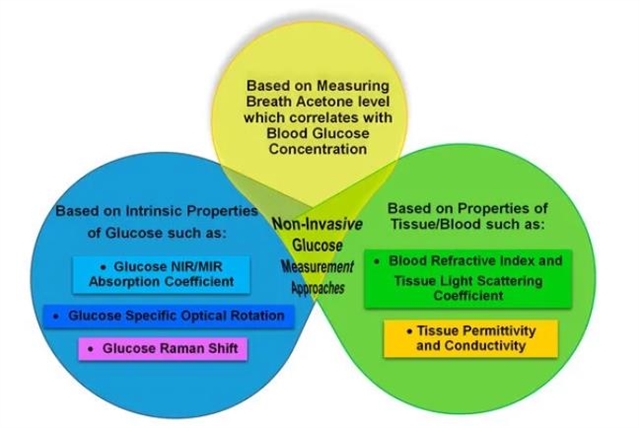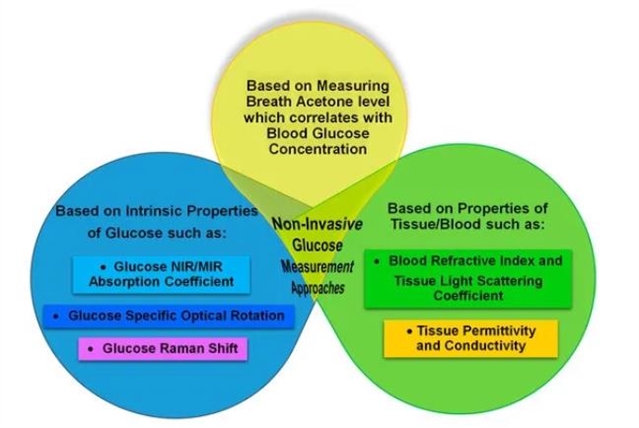|
|
|
|
|
跟传统指刺法说拜拜——非侵入性血糖传感技术来了!| mdpi sensors |
|
|
论文标题:review of non-invasive glucose sensing techniques: optical, electrical and breath acetone
期刊:sensors
作者:maryamsadat shokrekhodaei and stella quinones
发表时间:25 february 2020
doi:
微信链接:
期刊链接:
前言
糖尿病是一种代谢紊乱,其中血糖水平超过230 mg/dl为高血糖;低于65 mg/dl称为低血糖。糖尿病分为四类:1型糖尿病 (t1d)、2型糖尿病 (t2d)、妊娠期糖尿病和其他类型的糖尿病。采用传统指刺法进行血糖自监测 (smbg) 是迄今为止最准确的血糖检测方法。然而,这种方法痛感大且不便利,对于一天需要多次检查血糖水平的患者还有感染风险。非侵入性血糖传感技术可以弥补传统血糖监测方法的缺点。来自德克萨斯大学埃尔帕索分校的maryamsadat shokrekhodaei教授及其团队对非侵入性血糖传感技术进行了综述,并将结果发表在期刊上。

文章介绍了三类非侵入性血糖测量方法,分别是基于葡萄糖内在特性的方法、基于葡萄糖组织特性的方法,以及与葡萄糖浓度相关的呼吸丙酮测量。葡萄糖的内在特性包括葡萄糖吸收系数、葡萄糖特异性光学旋转和葡萄糖拉曼位移;组织特性包括组织光散射系数、组织穿透率和组织电导率,可用于测量葡萄糖浓度;呼气研究侧重于通过呼吸分析测量血糖,包括丙酮水平。
综述内容
1. 基于内在特性的非侵入性葡萄糖传感方法
依赖于葡萄糖的内在特性的非侵入性葡萄糖传感技术包括近红外/中红外 (nir/mir) 吸收光谱、光学极性测量和拉曼光谱。它们的核心内在特性分别是葡萄糖光学吸收系数、特定的光学旋转和拉曼移位。检测光与葡萄糖相互作用的传感器依赖于nir/mir吸收的变化、光的旋转角度和拉曼信号强度的变化。
• 中红外和近红外光谱
mir和nir吸收的光谱设置包括一个光源可产生mir或nir范围内不同波长的光,以及一个光探测器来测量光的强度,根据光的波长和强度通过样品反射或传输。中红外/近红外吸收光谱可以测量葡萄糖吸收度的变化作为波长的函数,并确定发生最高葡萄糖吸收时的光的波长。
• 偏振测定
偏振测定使用线性偏振光,测量当光通过光学活性溶液 (包括溶液中的葡萄糖) 时电场的旋转角度。极化光通过含有葡萄糖分子的样品将导致电场的角度从原来的角度旋转。电场的旋转角度取决于光学有源水溶液中的葡萄糖浓度,通过方程计算,可以得出样品的葡萄糖浓度。
• 拉曼光谱
大部分在nir范围内拉曼光谱设置包括一个高强度光源和一个非常敏感的拉曼光谱光探测器。根据葡萄糖分子的振动模式,在 911、1060 和 1125 cm−1 时观察到典型的葡萄糖拉曼指纹,在1125 cm−1时拉曼信号最强。根据以上原理使利用拉曼光谱探测器测量血糖值成为可能。
2.基于组织特性的非侵入性葡萄糖传感方法
组织和血液的光学和电气特性是一些非侵入性葡萄糖测量方法的基础。组织散射系数和血液折射率是两个光学特性,其值取决于葡萄糖浓度。基于这两种特性的生物阻抗光谱和毫米波/微波/超高频 (mmw/mw/uhf) 波传感技术可用于非侵入性血糖检测。散射/闭塞光谱法和光学相干断层扫描法是最为常见的方法。
3.基于呼吸丙酮分析的非侵入性葡萄糖传感方法
人类呼吸中含有数千种挥发性有机化合物,其中丙酮含量高,因此更易检测。与健康人相比,糖尿病患者呼吸中的丙酮含量更高,因为糖尿病患者的胰岛素水平较低,而胰岛素会抑制酮在人体内产生。健康人呼吸中的丙酮含量约为300 ppb到900 ppb,而糖尿病患者呼吸中的丙酮含量能够达到1800 ppb。先前研究表明,在22例t1d患者、312名t2d患者和52名健康个体中测得的丙酮水平平均值为4.9 ppm、1.5 ppm和1.1 ppm。糖尿病患者的呼吸丙酮水平较高意味着呼吸丙酮可以用作糖尿病诊断的生物标志物。
总结
本文以多学科的视角对非侵入性血糖测量方法进行综述。在囊括非侵入性技术的工程和实验学科的同时,本文还介绍了与血糖相关的生理学和生化学理论。跨学科协作对于高精度非侵入性检测设备早日在公众中推广应用而言至关重要。
期刊简介
(issn 1424-8220) 于2001年创刊,2019年最新影响因子为3.275,在jcr instruments & instrumentation学科分类中排名居q1 (15/64);2019 citescore 为5.0,在 scopus physics and astronomy: instrumentation 学科分类中排名居q1 (17/129)。作为一个国际型开放获取期刊,主要刊载传感器科学和技术研究领域的学术文章,采取单盲同行评审,一审周期约为15天,文章从接收到发表仅需2.6天。
摘要:
abstract
annual deaths in the u.s. attributed to diabetes are expected to increase from 280,210 in 2015 to 385,840 in 2030. the increase in the number of people affected by diabetes has made it one of the major public health challenges around the world. better management of diabetes has the potential to decrease yearly medical costs and deaths associated with the disease. non-invasive methods are in high demand to take the place of the traditional finger prick method as they can facilitate continuous glucose monitoring. research groups have been trying for decades to develop functional commercial non-invasive glucose measurement devices. the challenges associated with non-invasive glucose monitoring are the many factors that contribute to inaccurate readings. we identify and address the experimental and physiological challenges and provide recommendations to pave the way for a systematic pathway to a solution. we have reviewed and categorized non-invasive glucose measurement methods based on: (1) the intrinsic properties of glucose, (2) blood/tissue properties and (3) breath acetone analysis. this approach highlights potential critical commonalities among the challenges that act as barriers to future progress. the focus here is on the pertinent physiological aspects, remaining challenges, recent advancements and the sensors that have reached acceptable clinical accuracy.

review content
1. non-invasive glucose sensing methods based on intrinsic properties of glucose
there are several non-invasive glucose sensing techniques that rely on the intrinsic properties of glucose. these include near-infrared/mid-infrared (nir/mir) absorption spectroscopy, optical polarimetry and raman spectroscopy. the intrinsic properties central to each of these measurements are the glucose optical absorption coefficient, specific optical rotation and raman shift, respectively. sensors that detect the interaction of light with glucose rely on changes in the nir/mir absorption, the rotation angle of light, and the raman signal intensity.
(1) mid-infrared and near-infrared spectroscopy
mid-infrared (mir) and near-infrared (nir) absorption spectroscopy are measurement techniques used to acquire quantitative information about a tissue sample and probe its components.
(2) polarimetry
polarimetry uses linearly polarized light and measures the angle of rotation of the electric field as the light passes through an optically active solution, including glucose in solution.
(3). raman spectroscopy
the raman spectroscopy setup includes a high intensity light source, mostly in the nir range, and a very sensitive raman spectrum photodetector.
2. non-invasive glucose sensing methods based on tissue properties
optical and electrical properties of tissue and blood are a basis for some of the non-invasive glucose measurement methods. the tissue scattering coefficient and blood refractive index are two optical properties whose values depend on glucose concentration. two non-invasive glucose detection methods, scattering/occlusion spectroscopy and optical coherence tomography, function based on these two values. the tissue permittivity and conductivity are electrical properties of tissue which are also sensitive to glucose concentration. this dependency creates a basis for two other non-invasive methods.
5. non-invasive glucose sensing based on breath acetone analysis
breath analysis is one of the non-invasive approaches for diagnosis and monitoring of diabetes. the human breath contains thousands of volatile organic compounds (vocs) such as acetone which is found abundantly. acetone is one of the plasma ketone bodies produced in the liver when the acetyl-coa level increases due to lipolysis, where lipolysis is the body’s response when the glucose supply in the body is insufficient.
people with diabetes have higher levels of acetone compared to healthy people, since insulin acts as an inhibitor for ketones production, and diabetes patients experience low insulin levels. as a result, exhaled breath contains acetone that varies from 300 to 900 ppb in healthy people compared to more than 1800 ppb in individuals with diabetes. jiang et al. reported that the acetone levels measured in 22 t1d patients, 312 t2d and 52 healthy individuals have the mean values of 4.9 ppm, 1.5 ppm and 1.1 ppm, respectively. higher levels of breath acetone in diabetes patients imply that breath acetone can be used as a biomarker for a diabetes diagnosis.
conclusions
this review paper presents a multidisciplinary view of non-invasive glucose measurement approaches. interdisciplinary collaboration is essential for realizing highly accurate non-invasive blood glucose monitoring devices applicable for public use. this paper has been aimed to include not only the engineering and experimental disciplines associated with non-invasive techniques but also the relevant physiological and biochemistry theory related to blood glucose and other tissue components. an effort was made to explain how glucose measurements are affected by physiological factors and how their confounding effect can be minimized.


特别声明:本文转载仅仅是出于传播信息的需要,并不意味着代表本网站观点或证实其内容的真实性;如其他媒体、网站或个人从本网站转载使用,须保留本网站注明的“来源”,并自负米乐app官网下载的版权等法律责任;作者如果不希望被转载或者联系转载稿费等事宜,请与我们接洽。